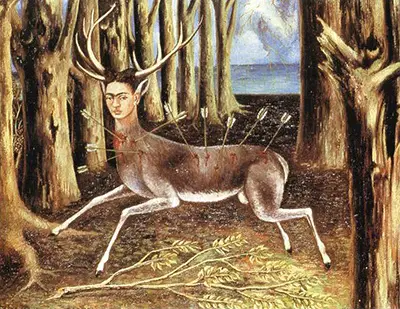Kahlo had hoped the operation would relieve some of the back pain she suffered following an accident she experienced much earlier in her life. The surgery did little to help her and this painting is possibly a reflection of the disappointment she was feeling at the time. Throughout her life Kahlo battled with physical difficulties as well as bouts of severe depression. Her paintings, especially in her latter years, have strong themes of pain and suffering as exhibited in this work.
Kahlo's style displays both Mexican and European influences which most likely stem from her German father and Mexican mother. The painting also hints towards her interest in Eastern religions and mysticism which she became interested in towards the end of her life. The deer in the work is most likely modelled on Kahlo's pet deer, Granizo. She owned many animals as pets which she regarded fondly as surrogates as she was unable to have children of her own following her accident at just eighteen years old.
The peculiar composition found in this artwork features Frida's head appended to a young deer. A careful examination of the background reveals broken branches in the forest which is likely to have been used to symbolise the artist's feelings of fear and desperation. Could she reach the bright outlook which sits right at the back of the scene, or would she remain trapped in this dense forest? When considering the arrows which penetrate her torso, it is worth considering the message left in the bottom corner of the painting - "Carma", refers to her destiny or fate, thus The Wounded Deer tells us of how the artist is unable to solve her ongoing problems, which would eventually define her career oeuvre and also her life in general.
In May, 1946, Kahlo gave the painting, The Wounded Deer, as a wedding gift to her close friends Linda and Arcady Boitler. With it she included a note to the couple which she had written by hand on a napkin that said: "I leave you my portrait to remember me all the days and nights since I left you. The sadness is portrayed throughout all of my paintings, but that's how my condition is, it cannot be fixed." The painting may be interpreted in many ways and there are many varying views on what Kahlo was conveying. As well as it being put forward that it expresses her pain and frustration at the failed surgery, others suggest it demonstrates her inability to control her own destiny.
Kahlo uses arrows to display physical pain in The Wounded Deer, and continues this technique in The Broken Column, where nails are used to symbolise the infidelity of her husband, Diego. In that painting it is Frida herself, but the difference here is that her head is superimposed onto a deer. She also makes use of a far busier background, with a natura forest setting, whilst she stands alone in front of a barren environment in The Broken Column. In a way, the use of this animal makes the painting a little more fun, even though she is describing her own pain and suffering. This source of inspiration can be found throughout her career, in what is a memorable and emotional oeuvre, with many being drawn to her honesty and vulnerability.
Various Interpretations of The Wounded Deer
No-one can deny that Frida Kahlo used large amounts of symbolism within her work, but many have argued over the precise meaning of some of these content additions. The Wounded Deer is no different in that regard. Most suggestions have tended to focus on some of the artist's negative emotions, but these can range from depression, heartbreak, frustration to loneliness and desperation. It can be hard to decipher which of these is being referred to within Kahlo's emotional ouevre. With regards this painting, some have suggested her incompetent surgery, her struggles to gain control of her life and even romantic problems as the root of inspiration for this painting. In truth, it might even be a mixture of all three.

